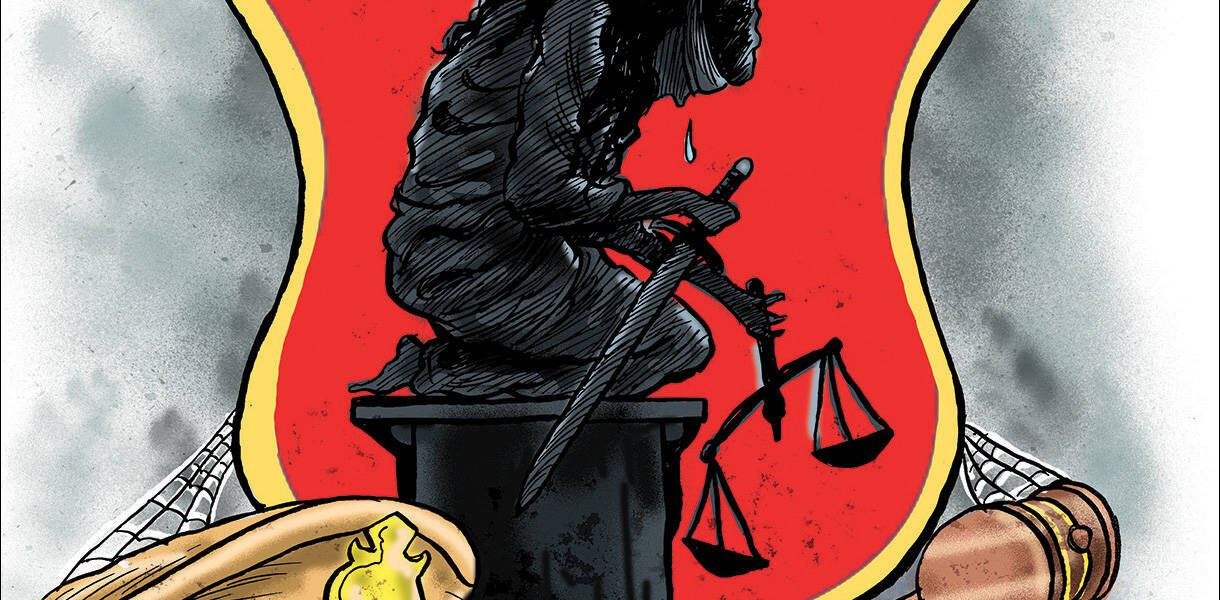

INTRODUCTION
“Step forward now, policeman. How shall I deal with you? Have you always turned the other cheek? To My church have you been true?”
The policeman squared his shoulders and said, “No, Lord, I guess I ain’t. Because those of us who carry badges can’t always be a saint.”
-The Final Inspection
In the poem, however, the policeman talks about how he had served the humanity right but the question is can all always be on the right side?
Though the Police are to protect the people of the country but we all have been a witness of how the same people have been a bane to the victims of crime, especially in cases of rape. There have been many allegations as to the police not taking action on time or outraging the character of the victim or forming their own opinions as to hamper the entire case or mislead the public.
According to the latest data released by the National Crime Records Bureau (NCRB), In 2019, India recorded 88 rape cases every day. There were a total of 32,033 reported rape cases in the year, as per the NCRB’s annual report titled “Crimes in India -2019“[1], maximum of which are reported from the states of Rajasthan and Uttar Pradesh, counting to 6,000 and 3.065 respectively, other states in line include Madhya Pradesh, Maharashtra and Kerala. It is also to be noted here that Rape vulnerability of girl or woman has increased up to 44 per cent in the last 10 years, the National Crime Records Bureau (NCRB) data shows. According to the NCRB data, during the period 2010-2019, a total of 3,13,289 cases were reported across India.[2]
Even though sexual crimes against women have been ascending quickly, the inhuman gang rape of 2012 shook the nation’s cognizance noteworthily. It prompted legislators to make amendments to the law of the country and come up with stringent punishment in cases of rape and sexual assault. But that has not been helpful as it should have been, the 2019 report[3] further tells us about how along with the amendments, the crimes have become sever as well. From 2013-2019 ie. after the Nirbhaya rape incident, around 2.42 Lakh rape cases have been reported which calculates to almost 95 rapes a day and further to 4 rapes every hour.[4]
This paper, however, revolves around the concept of how Police played an important role in being a bane, instead of a boon to the society. The paper focuses on various instances where there was breach of trust on part of the police with respect to the society who believes them to be nothing but saviors.
HATHRAS RAPE CASE (2020)
On 14th September 2020, a 19-year-old Dalit girl was gang-raped by four upper caste men, as has been alleged in Hathras district of Uttar Pradesh. After struggling for her life in a Delhi Hospital for two weeks, she succumbed to her injuries. Primarily, it was reported that there was an attempt to murder but later in her statement to the magistrate, the girl named four accused for raping her. The girl’s brother claims that no arrests were made in the initial 10 days after the incident. After she had died, the victim was cremated by Uttar Pradesh police without her family’s consent, even that they were locked up inside their home. The case and its consequent handling has received a lot of media attention and disapproval from the people across the country. The Allahabad High Court took up a suo moto cognizance.
The twist here lies in the woman being a Dalit and accused were upper-class men. When she was taken to the police station, her claims were denied and the police had humiliated the whole family for blaming the upper caste, and later after 6 days were their complaint was registered. This incident was first described as fake news, later the Superintendent of Police claimed that no sperm was found in the samples as per the forensic reports, therefore no rape had occurred ignoring the fact that there are certain guidelines that talk about swab samples to test for sperm are only be taken if the assault was occurred in the three days after the occurrence. A retired officer quoted by the BBC criticized that “Police officers should not jump to conclusions. The presence or absence of semen by itself does not prove rape. We need a lot of other circumstantial and other evidence.”[5] The police showed the Dalit woman’s rape as no rape, her murder as no murder. Burning the victim’s body at 2:30 in the morning without her parents’ or community leaders’ consent nor knowledge is to clear out the evidence of rape and murder since burning the body would burn the evidence forever.
TUKARAM v. STATE OF MAHARASHTRA (1978)[6]
On 26th March, 1972, a tribal girl of age group 14-16 years was raped by two policemen inside the Desaiganj Police Station in Gadchiroli district of Maharashtra. Mathura worked as a domestic helper with a woman. She met her nephew named Ashok who wanted to wed her, but Mathura’s brother did not agree to the union and therefore he lodged a complaint in the local police station stating that his sister at the time a minor, was kidnapped by Ashok and his family. Subsequently, the police authority brought Ashok and his family members to the police station. After the general investigation had taken place, Mathura, her brother, Ashok, and his family members were allowed to go back to their homes. But, as they were leaving, Mathura was asked to stay behind inside the station while her relatives were asked to wait for her outside. Mathura was then raped by the two policemen. When her relatives and the gathered crowd threatened to burn down the police station, the accused policemen, Ganpat and Tukaram, hesitantly agreed to file a Panchnama (legal recording of evidence). The defense provided by the accused was that Mathura was habituated to sexual intercourse and did not raise any alarm, therefore the situation could not be termed as rape but merely sexual intercourse.
After the Supreme Court held in favor of the accused, there was public commotion and protests, which eventually led to the amendments in the Indian rape law via The Criminal Law Amendment Act 1983 (No. 43).
ARATI MAJHI v. STATE OF ODISHA (2014)[7]
In this case, the petitioner happens to be the so-called victim. The father of the petitioner in his petition under Section 176(1-A) of the Code stated that on 12.2.2010 at about 4 A.M. in the night while Special Operation Group and Central Reserve Police Force were conducting anti Naxalite search operation in village Judingi, the villagers were assaulted and his daughter (the victim) and his nephew were taken into custody by the Central Reserve Police Force. The father of the petitioner alleges in his petition that the victim and his nephew were assaulted and taken to some unidentified place. It is further alleged that he came to know that his daughter and his nephew were transferred to Police Camp at Parlakhemundi where they were tortured by the Central Reserve Police Force and his daughter was gang raped and they were referred to judicial custody at R.Udayagiri Sub-Jail. The father of the petitioner alleged that the face of his daughter and his nephew were covered with black cloth while producing before the Magistrate and were not allowed to say out their objections before the Magistrate. He further alleged that he met his daughter in R.Udayagiri Sub-Jail in the month of March where she specified about the gang rape committed upon her by three C.R.P.F. police personnel in the Camp at Parlakhemundi. The father of the petitioner further stated that he met his daughter at R.Udayagiri Sub-Jail five times where his daughter described about the gang rape by the C.R.P.F. officials. He further alleged that he made depiction to the authorities alleging about the rape committed by the C.R.P.F. officials on her daughter that went futile. He also stated that his daughter was in custody in linking with five cases, and was an under trial prisoner at Sub-Jail, R.Udayagiri.
VASANTHI v. THE HOME SECRETARY (2013)[8]
In this case, the court was of the view that, when serious accusations of custodial rape have been alleged by a lady, she should not be under fear that the investigation may not be conducted fairly by the Superintendent of Police. As the doubt will be always haunting in her minds based on the press note issued by the Superintendent of Police, the party should not have any fear or anxiety with regard to conduct of investigation by the police authorities especially, petitioner’s case is a custodial rape.
The aforesaid circumstances lead this Court to conclude that it may not be safe and proper to conduct an investigation by the respondent police on the petitioner’s complaint, as she firmly made accusation of custodial rape and assault by the police officials instigating injuries on the petitioner in the custody. The grievous injuries sustained by the petitioner are very serious and other serious accusations made by the petitioner have to be essentially looked into, and they cannot be ignored and enquired exhaustively. The Hon’ble Supreme Court in a judgement in State of Punjab v. CBI[9] and others, declared that when serious accusations are made against the police officials and higher officials, it will be safe to entrust the matter to an independent agency for enquiry or investigation. In view of that independent agency is to be assigned with the matter to look into the allegation of the petitioner, conduct enquiry and register FIR if cognizable offence is made out.
SUO MOTO v. STATE OF RAJASTHAN (2005)[10]
Section 376A punishes sexual intercourse with wife without her consent by a judicially separated husband. Section 376B punishes sexual intercourse by a public servant with woman in his custody. Section 376C IPC punishes sexual intercourse by Superintendent of Jail, Remand Home etc. with Inmates in such institutions and Section 376D punishes sexual intercourse by any member of the management or staff of a hospital with any woman In that hospital. These new Sections were introduced with a view to stop sexual abuses of women in custody, care and control by various categories of persons which though not amounting to rape were nevertheless considered highly reprehensible. The new amended Section 376 IPC now prescribes a minimum punishment of seven years’ imprisonment for the offence of rape. For combating the vice of custodial rape, rape on pregnant woman, rape on girls under 12 and gang rape, a minimum punishment of 10 years’ imprisonment has been made obligatory. However, for special reasons to be recorded in the judgment, the Court in either case can Impose a sentence lesser than seven or ten years, as the case may be. A further Improvement in the law relating to sexual offences can be found in the provisions of Section 228A IPC, Section 327(2) Cr.P.C. and Section 114A Evidence Act. Consent, by and large, has been viewed as a valid and strong defensive weapon. The defence lawyer in his endeavour to elicit a case of consent hackle and humiliate the woman in the cross examination. Thus, an amendment has been brought in Section 114A Evidence Act which provides for the presumption as to the absence of consent in cases of custodial rape, rape on pregnant woman and gang rape as in Clauses (a), (b), (c), (d), (e) and (g) of Sub-section (2) of Section 376 IPC.
RAM KUMAR v. STATE OF HIMACHAL PRADESH (1995)[11]
The woman was married to Khem Raj. Both were residents of Chadigarh, from there they went to Rajgarh (Himachal Pradesh ) to meet Chuhar Singh who was the brother of Khem Raj. On the night of the incident, the victim and her husband were sleeping in the Chuhar Singh’s house, at almost around midnight they were awakened by the two policemen, Nain Singh was the Investigating Head Constable of the Rajgarh Police Station and Ram Kumar was just another constable. They alleged falsely that a wireless message has been received from Chandigarh Police Station specifying the woman is an abducted girl therefore, she and Khem Raj were taken to the police station. There they were kept in single rooms. Nain Singh, brutally hit the woman, then he molested her, and finally raped her. Her screams were heard to Khem Raj’s room who was confined Ram Kumar sat outside guarding him, without reacting. His action shows a mind of uniformity in aiding and abetting the commission of rape. Her word combined with that of Khem Raj and Chuhar Singh alongwith that of the local people who saw both being taken to the Police Station. Dr. Rama Nand, approached by Chuhar Singh, to seek help because of the illegal detention of both, also was a witness. The High Court held conclusion the appellants guilty.
SANGAIYYA v. THE STATE OF TAMIL NADU (2010)[12]
The Hon’ble Supreme Court, on the issue of payment of compensation to the victims of physical assault, humiliation, torture, rape, custodial death etc. and where there is an infringement of constitutional right to life and liberty under Article 21 of the Constitution of India is concerned in this case held that compensation should be given where investigation is pending and after the conclusion of the proceedings are taken against the police officials.
However, there is no specific method to calculate the quantum of compensation, in cases where vicarious liability is established on the State Government, for tortious acts committed by the officers of the Government or where there is a prima facie proof of their contribution to the cause of death or custodial violence, torture, or case of rape, physical assault, etc., the Court, while computing the compensation, should apply the method followed in the Motor Vehicles Claims cases, where, the victim has to be awarded “just compensation”.
SMT. RAMEEZA BEE CASE (1978)
In this case, Rameeza Bee was a 26-year-old working female who was returning home along with her husband, Ahmed Husain who was a rickshaw puller. They were on their way to their house but they were arrested by the police officers for loitering late in the night. They were asked to pay a fine. Rameeza was kept in custody and was raped by the three police officers while her husband was sent home to bring money to pay the fine. After his return, he protested against the assault committed by the policemen upon his wife but he was beaten mercilessly to death by the policemen.
Later, Rameeza Bee complained about the incident which led to violent protests and riots and four policemen were even suspended. Due to the results of such activities, an inquiry commission was set up to inquire about the rape of Rameeza Bee and the death of Ahmed Husain. During the period of commission’s proceedings, the police defended the murder and rape by putting questions on the character of the victim and tried proving that Rameeza Bee was married several times earlier and her marriage to Ahmed Husain was not a lawful marriage and she was wrongfully cohabiting with him.
However, the commission stated that the police officers guilty of rape as well as murder and they shall be prosecuted. Subsequently, they were acquitted on the grounds stating that evidence recorded by the inquiry commission was inadmissible in the session’s Court.[13]
SHEO KUMAR GUPTA v. STATE OF U.P. (1988)[14]
In this case, the woman was travelling in a car with her husband Ishwar Tyagi and two of his friends when their car broke down near Baghpat police station. The husband and the friends left to get the tyre repaired. After they left, a police officer in plain clothes came in and molested the woman. When her husband husband saw this he slapped the police official. This police officer after leaving came back with 10 policemen who shot dead Ishwar Tyagi and his two friends. The victim was afterwards dragged out of the car, stripped naked and was paraded through the market. When there was resistance on her part they attacked her by inserting the lathi into her. Later, she was taken to the police station and was ruthlessly tortured and false accusations were imposed on her which stating her as a dacoit’s mistress who was covering up for his killings. In the course of the judicial inquiry, the accused tried to justify their actions by saying that the woman was of loose character since her marriage to Ishwar Tyagi was her second marriage due to which she deserved such violence. On the accusations which were put on Maya Tyagi, the Court held that they were false as they were not dacoits and were malafidely framed by the police officials. The Judicial Committee found out that the torturous incidents stated by Maya Tyagi upon her by the police officials were true. However, there was no penetration and later the police officials were acquitted.
REFORMS TAKEN UNTIL NOW
1. Expansion of the Term ‘Custody’- Even though the notion of Custodial rape arose in the context of rape of women within the premises of the police station by the police officials, the law has given a broadened the meaning to the term ‘custody’. The law changed in 1983 to introduce the concept of custodial rape, and expand the understanding of custody to include:
- Rape by a police officer within the limits of the police station to which he is appointed, in the premise of a station house or on a woman in such police officer’s custody or in the custody of a police officer subordinate to such police officer;
- Rape by a public servant on a woman in the public servant’s custody or in the custody of a public servant subordinate to him;
- Rape by a member of the armed forces in an area where the forces have been deployed;
- Rape by a member of the management / staff on an inmate in a jail, remand home, women’s home, children’s home or other place of custody; and
- Rape by a member of the management / staff of a hospital, on a woman in the hospital.[15]
2. Shift in Onus of Proof
Fundamentally, in criminal law, the weight is on the prosecution ie. the party representing the State to demonstrate that the accused executed the offence, as the state has more powers and the means available with it to demonstrate the charge against the accused. The accused is assumed blameless until proven guilty, is the principle rule of criminal law.
In the instances of custodial rape, a exceptional case for the principle of presumption of guilt was cut out in 1983 in instances of custodial rape after considering Section 114A of the Indian Evidence Act. According to this section, if the prosecution proves the case of sexual intercourse, and the lady expresses that it was without her consent, at that point the court will assume that there was non consent. The onus of proof would then be upon the accused to demonstrate that the lady consented.
3. Enhanced Punishment
The sentence prescribed for an offence is a pointer of the graveness with which law treats it. Through amendments to the law in 1983 and later, the punishment available for custodial rape has expanded when compared with rape by any other individual. At least 10 years rigorous imprisonment, up to life imprisonment that is for the rest of that individual’s natural existence with fine has been endorsed in law.
4. Failure To Perform Duty As A Punishable Offence
Unexpectedly, through amendments in law in the year 2013, the disappointment of government authorities to help a survivor of rape came to be perceived as a punishable offence. The police has an obligation to register the FIR and to do so expeditiously. A punishment of a half year to 2 years imprisonment is endorsed for a government worker violating the law, under S. 166A IPC.
SUGGESTIONS
- Social Audit- There must be a stringent policy followed in order to publicize the statistics of custodial rape cases and the negligence incurred by police while dealing with rape cases, such audit should be transparent to the public. Police officers acting in negligent ways should be dealt with in a stricter manner. Action and non-action are more influenced by politics than the motivation to ensure the rule of law. That is why reports on police reforms and criminal law reforms, including the 14-year-old Supreme Court judgment in Prakash Singh[16], have been ignored by the political powers.
- Stricter Punishment- The police officers indulging in activities hampering the investigation, or being a part of the problem themselves amount to breach of trust of public, since they are supposed to be their guardian.
- Tighter Provisions- When it comes to the police stations and the working of the state machinery, provisions should be implemented which make evidence collection, recording the statements of victims a lot easier like female police officers should be there at all times while handling with cases of rape, additional security should be provided to the family of the victim by default in order to protect them and the sanctity of the legal process as well.
- Handling of evidences- The most important action item while a rape case comes to light is to send the survivor for clinical examination and to gather the evidences identifying with the case. Strict responsibility ought to be kept up with regards to treatment of the evidences. In 1886, the US Supreme Court in Yick Wo v. Hopkins[17] held that “the law itself be fair on its face, and impartial in appearance, yet, if it is applied and administered by public authority with an evil eye and an unequal hand, so as practically to make unjust and illegal discriminations between persons in similar circumstances, material to their rights, the denial of equal justice is still within the prohibition of the constitution”. B R Ambedkar talked on similar lines while outlining our Constitution.
- Mandatory registration of FIR- FIR ought to be registered when a rape case comes to light, regardless of whether the police thinks prima facie if the rape happened or not. The government’s control on the police is with the end goal that even the Supreme Court’s bearing for the registration of FIRs for cognizable offences isn’t clung to by the police framework. In 2003, the Justice Malimath Committee suggested that the registration of FIRs ought to be the compulsory duty of the police and the breach of this duty should turn into an offence punishable in law to forestall the abuse of power by the official. At that point came a Supreme Court judgment expressing if the information given unmistakably specifies the commission of a cognizable offence, there could be no other alternative except for to register FIR forthwith. Indeed, even today, for non-registration of complaints, one needs to approach the courts of justices and the cases stay forthcoming for quite a long time.
- Cordial Attitude- Instead of censuring and victim blaming, there ought to be strict regulations as to respectful treatment of the person in question and her family so that such cases don’t move dismissed because of the mortification the person in question and her family needs to face. Police officials are oftentimes seen to hold negative perspectives about rape survivors. Police officials’ attributions of rape survivors fault, appraisals of rape survivor’s statement’s validity, and rape myth acknowledgment ought to be taken care of in a cautious way.
CONCLUSION
It is problematic to prosecute and punish a person accused of rape, it is even more difficult when it comes to custodial rape. State, especially the police is seen so as to be the protector of the public due to which it is the state that is the prosecutor in rape cases, and not the actual victim. However, this law does not stand to be true when it comes to the cases of custodial rape.
Because the cases of custodial rape take place inside the police stations, jails or other places which are run by or are under the control of the state/central government, the evidence available for the case is within the control of the public servants. There is a huge possibility for them to do away with the evidence from the place of crime. To counter this, the women’s movement asked for a shift in onus of proof from prosecution to accused in custodial rape cases.[18]
When it comes to reality, it is a huge task to even register an FIR against the police. Following are the problems encountered by women with registering FIRs:
- First and foremost is the part where the police refuse to accept the complaint of the victim. This could be because of the authority of the Police Standing Orders, or the immunity for offences granted under laws of the country such as the Armed Forces Special Powers, 1958 which gives protection to the Police, Central (Armed) Reserve Police Forces or the Army.
- Even if FIR is registered, Section 197 of CrPC[19] prescribes that a public servant cannot be prosecuted for any offence for any act done while his discharging the official duty, without the prior permission of the state or central government, either was the power that appointed him.
- The practice carried on by the police of recording complaints in the form of Community Social Register (CSR) rather than FIR, thus eliminating the chance of recording the offence and making it come outside the purview of CrPC as well as removing the safeguards it provides to the victims.
- The effect of politics it has on suppressing the crime statistics, therefore neglecting the statistics of custodial rape which almost never sees the light of the day.
- The problem does remain that as protectors to the criminal justice system (Spohn & Tellis, 2012), police officers hold a somewhat distinctive role in enabling victims to achieve justice for their victimization. Therefore, the effect of police officers holding negative attitudes about rape victims may be far superior than that of individuals within the general population. Police officers’ blame and reliability assessments do seem to be affected by both victim and participant characteristics, but there is a lack of dependability in the research findings.
As stated there are various substantial challenges which are still to be addressed in order to improve the criminal justice system to provide justice to the rape victims, of which police officer’s harassment represents one area to look after for future development. It is accepted that police officers not only play a major part in the criminal justice systems that offers challenges to rape victims. The examination of this crime requires major obligations on the part of victim, particularly in the area of forensic collection of evidence and the reckless nature of the crime itself. This is the crucial challenge which lies between the needs of the victim as well as the need for police investigation. Moreover, the importance of a optimistic response and support provided by police officers is not to be underestimated.
About The Author
Muskan Rathore is a 4th year Law student at NUSRL, Ranchi. She has an immense interest in Criminal Law and Human Rights Law. Being a judiciary aspirant, she is quite a smart worker with an immense interest in legal research work and article writing.
Sagar Rana is a penultimate year law student at NUSRL, Ranchi. He is a judicial aspirant and is currently pursuing B.A LL.B (Hons.) with a specialization in Criminal Law. He also has a keen Interested in Civil and Gender Laws.
Photo Source: The Times of India
References
-
https://ncrb.gov.in/sites/default/files/CII%202019%20Volume%201.pdf
Data for J&K, Ladakh and West Bengal not available therefore, data furnished for 2018 for these has been used. ↑
-
https://www.indiatoday.in/diu/story/no-country-for-women-india-reported-88-rape-cases-every-day-in-2019-1727078-2020-09-30 ↑
-
https://ncrb.gov.in/sites/default/files/CII%202019%20Volume%201.pdf ↑
-
https://www.indiatoday.in/diu/story/no-country-for-women-india-reported-88-rape-cases-every-day-in-2019-1727078-2020-09-30 ↑
-
Biswas, Soutik (2 October 2020). “Hathras case: Are Indian state police trying to discount a woman’s story of rape?”. BBC News. Retrieved 2 October 2020. ↑
-
Tukaram V. State Of Maharashtra, 1979 AIR 185. ↑
-
2014 (4) ORI 40. ↑
-
LQ 2014 HC 16121. ↑
-
2011 (9) SCC 182. ↑
-
2005 (4) WLC 163. ↑
-
AIR 1995 SC 1965. ↑
-
2010 (8) MAD 169. ↑
-
Vimla Farooqi, A Woman Destroyed: An Interview with Rameeza Bee, in IN SEARCH OF ANSWERS: INDIAN WOMEN’S VOICES FROM MANUSHI 186 (Madhu Kishwar & Ruth Vanita, 10th ed., 1986). ↑
-
AIR 1978 All 386. ↑
-
1979 AIR 185. ↑
-
Prakash Singh & ors. v. Union of India, (2006) 8 SCC 1. ↑
-
118 U.S. 356 (1886). ↑
-
https://feminisminindia.com/2019/04/16/custodial-rape-india/ ↑
-
Prosecution of Judges and public servants.
(1) When any person who is or was a Judge or Magistrate or a public servant not removable from his office save by or with the sanction of the Government is accused of any offence alleged to have been committed by him while acting or purporting to act in the discharge of his official duty, no Court shall take cognizance of such offence except with the previous sanction-
(a) in the case of a person who is employed or, as the case may be, was at the time of commission of the alleged offence employed, in connection with the affairs of the Union, of the Central Government;
(b) in the case of a person who is employed or, as the case may be, was at the time of commission of the alleged offence employed, in connection with the affairs of a State, of the State Government: 1 Provided that where the alleged offence was committed by a person referred to in clause (b) during the period while a Proclamation issued under clause (1) of article 356 of the Constitution was in force in a State, clause (b) will apply as if for the expression” State Government” occurring therein, the expression” Central Government” were substituted.
(2) No Court shall take cognizance of any offence alleged to have been committed by any member of the Armed Forces of the Union while acting or purporting to act in the discharge of his official duty, except with the previous sanction of the Central Government.
(3) The State Government may, by notification, direct that the provisions of sub- section (2) shall apply to such class or category of the members of the Forces charged with the maintenance of public order as may be specified therein, wherever they may be serving, and thereupon the provisions of that sub- section will apply as if for the expression” Central Government” occurring therein, the expression” State Government” were substituted.
(3A) 1 Notwithstanding anything contained in sub- section (3), no court shall take cognizance of any offence, alleged to have been committed by any member of the Forces charged with the maintenance of public order in a State while acting or purporting to act in the discharge of his official duty during the period while a Proclamation issued under clause (1) of article 356 of the Constitution was in force therein, except with the previous sanction of the Central Government.
(3B) Notwithstanding anything to the contrary contained in this Code or any other law, it is hereby declared that any sanction accorded by the State Government or any cognizance taken by a court upon such sanction, during the period commencing on the 20th day of August, 1991 and ending with the date immediately preceding the date on which the Code of Criminal Procedure (Amendment) Act, 1991 , receives the assent of the President, with respect to an offence alleged to have been committed during the period while a Proclamation issued under clause (1) of article 356 of the Constitution was in force in the State, shall be invalid and it shall be competent for the Central Government in such matter to accord sanction and for the court to take cognizance thereon.]
(4) The Central Government or the State Government, as the case may be, may determine the person by whom, the manner in which, and the offence or offences for which, the prosecution of such Judge, Magis- trate or public servant is to be conducted, and may specify the Court before which the trial is to be held. ↑





Hi, I log on to your blog like every week. Your humoristic style is witty,
keep it up!
Hey! Someone in my Facebook group shared this website
with us so I came to check it out. I’m definitely enjoying the information. I’m book-marking and will be tweeting this to my followers!
Wonderful blog and amazing design.
Definitely believe that which you stated.
Your favorite reason seemed to be on the net the simplest thing to be aware of.
I say to you, I definitely get irked while people
think about worries that they plainly don’t know about. You managed to hit the nail upon the top and defined out the whole thing without having side effect
, people can take a signal. Will probably be back to get more.
Thanks